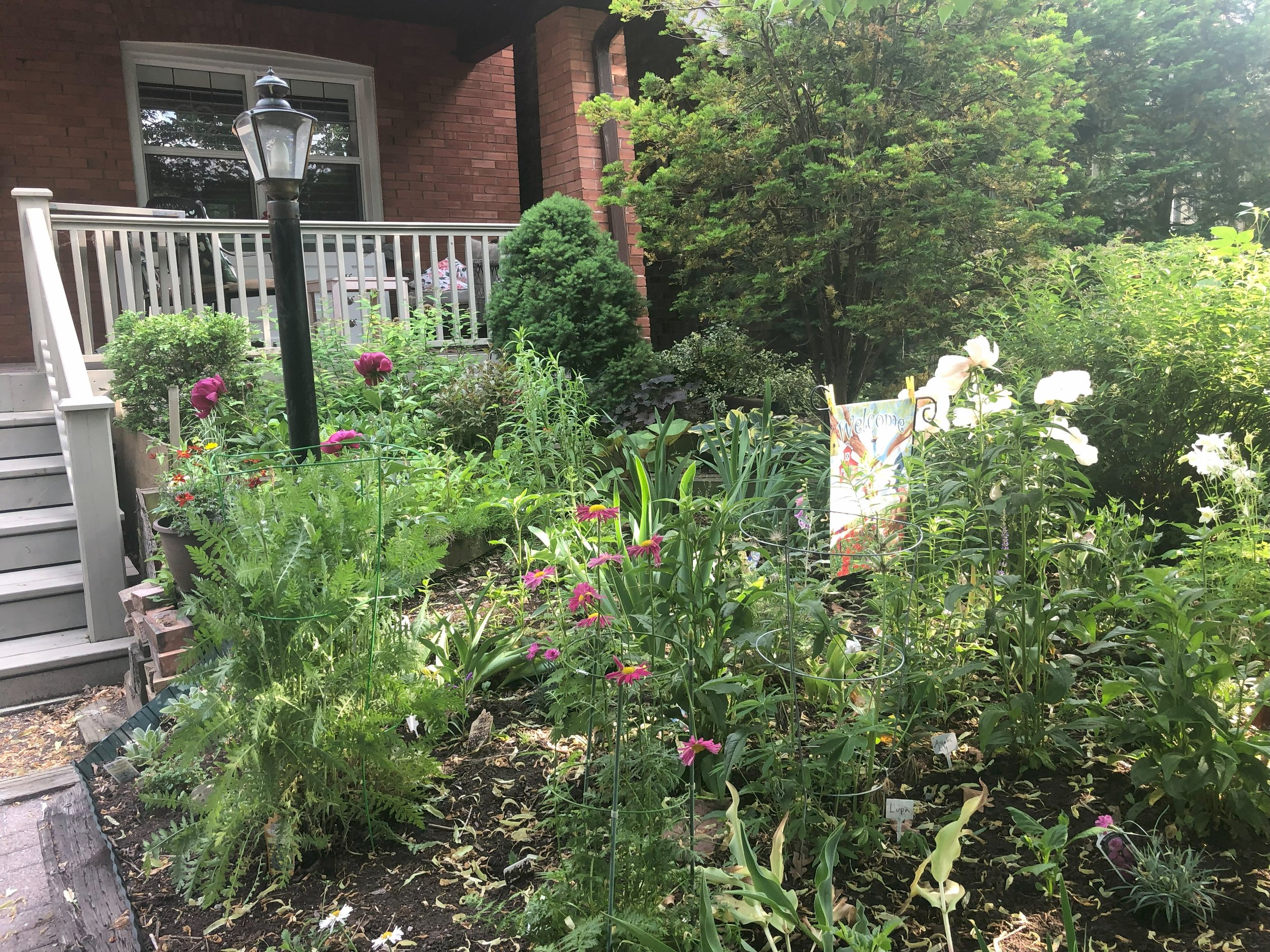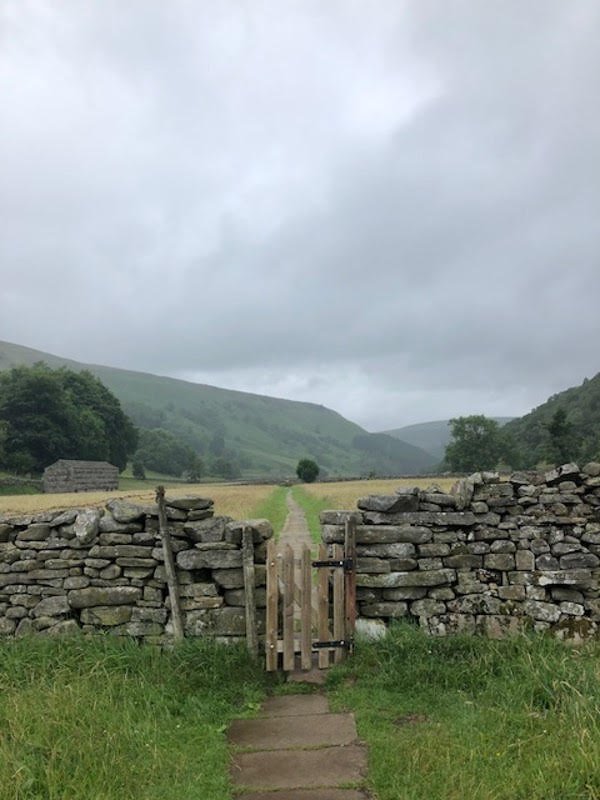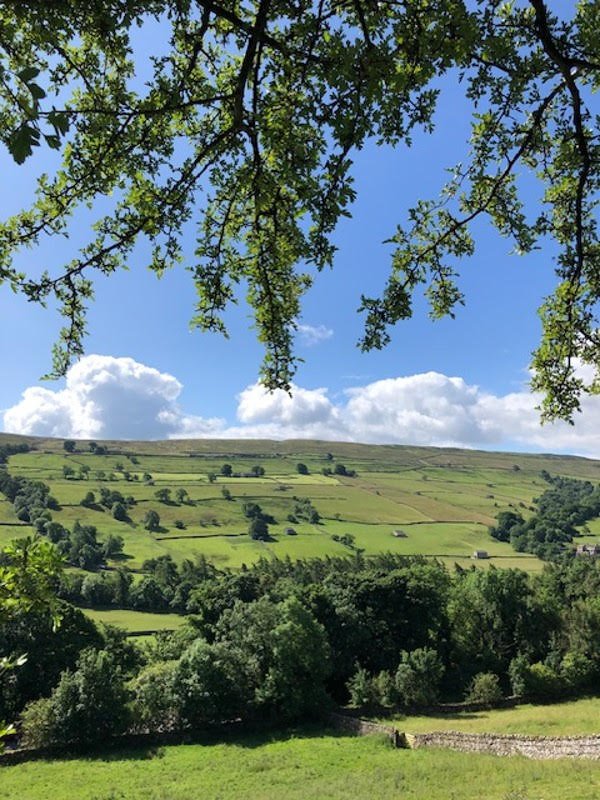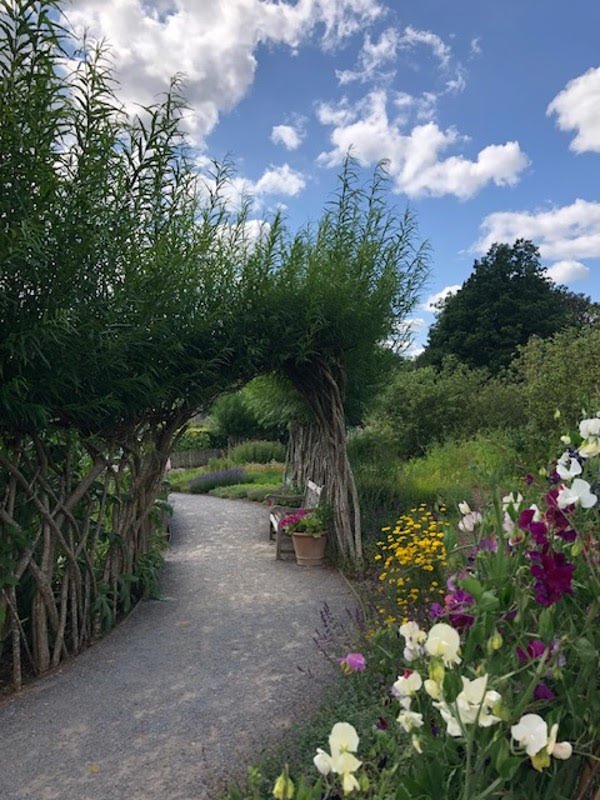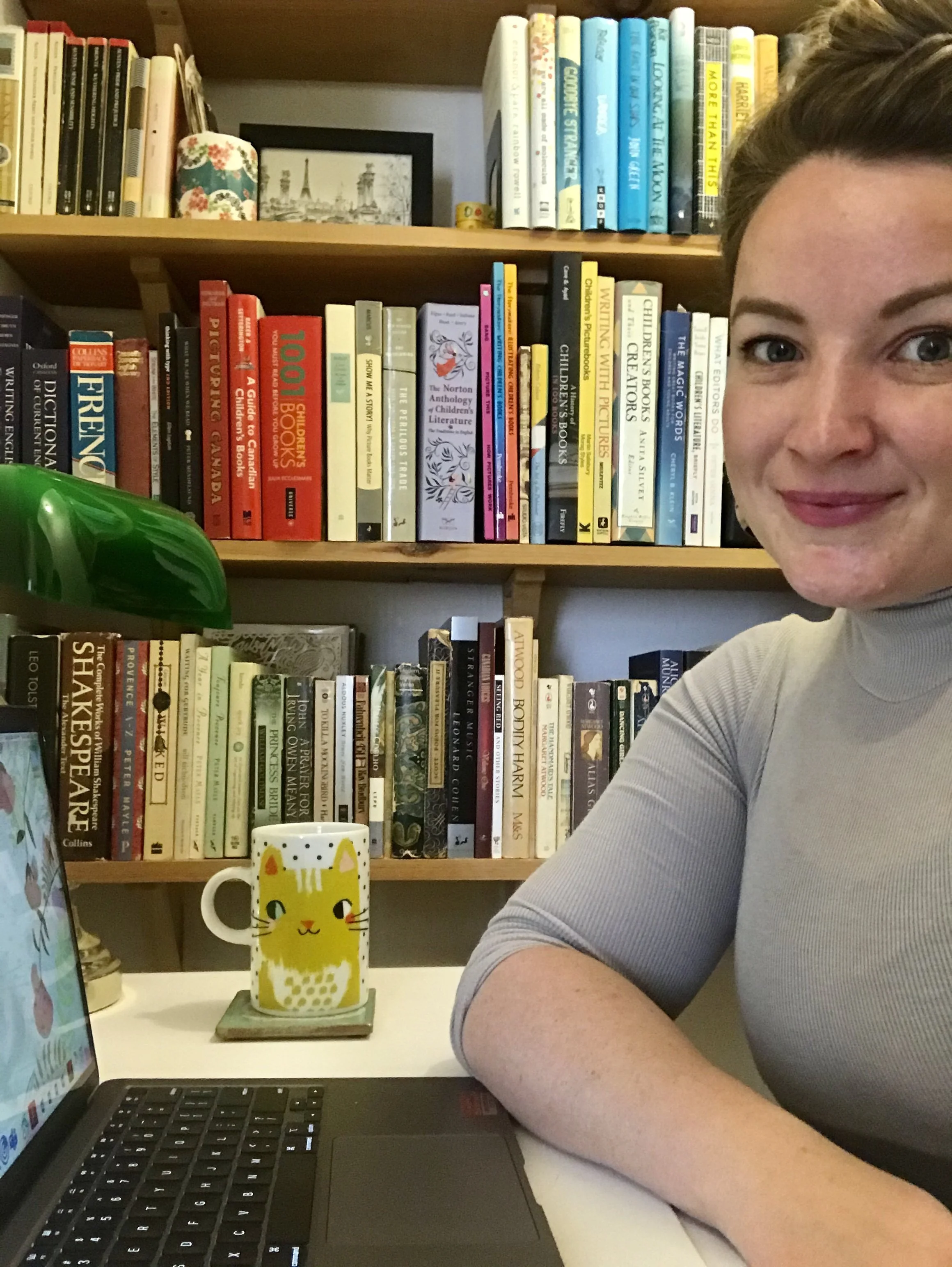Team Beatrice and Barb: Jennifer D. Foster, Copy Editor
Jennifer D. Foster, copy editor, walking the Yorkshire Dales this past summer.
Picture books are, by their nature, short. The shorter a text is, the more weight each word carries. This means that, by the time a picture book manuscript reaches the copy editor’s inbox, every sentence has been agonized over and reworked many times. The story has passed through the hands of many talented readers, all on the lookout for errors. Which is why, when I received my notes from Beatrice and Barb’s copy editor Jennifer D. Foster, I was shocked to see how many there were!
Diving into all those comments, I began to better understand the complex nature of copy editing, as well as Jennifer’s formidable skill. She wasn’t simply pointing out typos and spelling mistakes, she was finetuning the story, calling attention to instances where my prose could be clearer, tighter, or more precise. I’m so grateful for those notes— applying them brought the story into sharper focus and made it undeniably stronger.
1. I think many people don’t know that there are multiple types of editors who work on a book. Could you explain what, in a nutshell, the job of a copy editor entails? It is so much more involved than just correcting typos!
Before I write anything else, I’d like to thank you, Kate Jenks Landry, for this wonderful opportunity! It’s not often those behind the scenes in the book publishing world get acknowledged and appreciated in such a public way and have the chance to share our thoughts on, processes involved with and our role(s) in the big, wide world of book publishing and beyond. And I’m very grateful.
A “nutshell” answer isn’t really possible here, and you’ll see why shortly! A copy editor’s job is a highly detailed, multi-faceted one, and they are, like any other expert working on a manuscript, a vital piece of the editorial puzzle. They review final/approved content to improve its overall readability and focus on the mechanics of language and words—the nuts and bolts of the text—before the manuscript is published. Yes, they focus on spelling, grammar and punctuation. But a copy editor also focuses on:
clarity (Is this the clearest, best possible way to state this message?);
consistency/continuity (if little Billie’s coat is brown on page 2, but yellow on page 3, that needs to be addressed);
sentence structure, flow and tone (kindly pointing out redundancies; awkward, illogical or ambiguous phrasing; clichés; jargon; weak wording; and suggesting alternatives);
confirming the facts and details (Did the Second World War end in Europe on May 8, 1945?);
following house style (if the client provides one);
ensuring the language is accessible and inclusive for the intended audience, all while maintaining the author’s voice and vision. A skilled copy editor will not only advocate for the reader, but also bring out the best in the writer.
In some cases, copy editors may be asked to create a house style (if working for, say, a self-publishing author or a new publishing company). And, quite often, copy editors are asked to create a detailed style sheet for the manuscript, which is then shared with and followed by the proofreader, the production editor and the handling/managing/executive editor, often along with any others who have a final say on the manuscript before it’s published, such as the author and the publisher/owner of the publishing house.
Finally, some copy editors also review and edit appendices, bibliographies, citations/references, etc., and/or point out possible issues of libel and/or plagiarism.
2. Creating PBs really is a team sport. What do you love about the collaborative nature of this process? What can be a challenge?
I adore reading and working on picture books. They are deceptively simple, and publishing one is—you’re so right— a team sport. I value each person’s role on the editorial team and am honoured to be part of the process, whether my role on a particular piece may be that of manuscript evaluator, developmental editor, line editor, copy editor or proofreader (or any combination of those roles, depending on the client). I think it’s truly amazing how each person has a definitive role to play along the way, each of which is unique and crucial to realizing the whole. It really does take a village to produce a book. And I always feel privileged to be part of the author’s journey in helping them make the book the best it can be and helping them realize their goal.
What can be a challenge is missing a typo/error in a picture book manuscript. I always read the text in my head first several times, then out loud several times. Even though a picture book usually has only a few words on a page, you’d be surprised how your mind’s eye fills in missing letters or words when you only read in your head. But if you read aloud, you’ll always stumble and then catch when a word is misspelled, a letter or word is missing, a letter or word is in the wrong place or if the sentence just seems “off” somehow.
3. How did B+B find you? What was your journey with this story like?
Kids Can Press has been a regular client of mine for many years, and I absolutely love the content the company produces and its socially responsible mandate. Jennifer Grimbleby, Kids Can Press’s managing editor, emailed me back in August 2021, asking if I was available and interested in copy editing Beatrice and Barb. After reading her brief description of the story, I jumped at the chance to work on such an original and heartwarming manuscript. As I do with each editorial assignment, I clarified the optics of my role (asking lots of questions, including which spelling (American or Canadian?) to use, whether a style sheet needed to be created, the level of copy editing required, due date, etc.), then signed the contract and dove in.
Less than a week later, I sent her my copy edited version in Word’s Track Changes, which included many notes/comments, rewording suggestions and questions, and changes for grammar, spelling, punctuation and consistency, and to reflect house style. At that point, my role was complete, but I was thrilled to be part of the team that produced this powerful celebratory tale of friendship, perseverance, responsibility, kindness and taking care of those we love.
And when Jennifer approached me several months ago to see if I’d like to be part of Kate’s blog series, of course I said “Yes!” I also asked for a copy of the book, and when I received it, I was thrilled to see not only my changes for spelling, grammar, punctuation, house style, etc., were made, but also that some of my comments and rewording suggestions were considered and reflected in the final text. It’s always so wonderfully rewarding to see your work in action, so to speak, in the finished product!
4. What does a typical work day look like for you? Can you tell me a bit about your work space?
I wear myriad work hats in a day and I wouldn’t want it any other way—ever. Through my company, Planet Word, I offer a wide selection of freelance editorial services: line editing, copy editing and proofreading; writing; researching; project and content consultation/management; fact-checking; manuscript review/evaluation; mentoring; and book-award judging. And I work on everything from fiction, non-fiction and children’s books, web content, trade and consumer magazines, e-blasts/(e-)newsletters and style guides to curatorial content, plans/reports/guides, book reviews, recipes and press releases.
So, I can be copy editing magazine features for a dental magazine, then writing a book review for a middle-grade non-fiction book, then mentoring a novice or transitioning editor, then proofreading an annual report for an art gallery or blog copy for a bank and then doing a developmental edit for a picture book for a self-publishing author—sometimes all within the same day!
I love the versatility and challenges of being a freelancer and working on many different kinds of projects for many different kinds of clients, as well as the mental stimulation and satisfaction all of it provides me. I’m curious by nature and thrive on variety.
My “office” is in our dining room of the main floor our two-storey home, with a south-facing sliding door that looks out onto our back deck. In the summer, I’m surrounded by innumerable plants, trees and flowers and hear bird’s chirping, children playing and people chatting when my windows and sliding door are open. In the winter, I get to see the magical winter skeletons of snow-covered trees. And I’m right beside our kitchen—“yay” to easy-to-reach snacks and herbal tea!
I always have music on when I’m working (see my reference to music in the next question), often am burning beeswax candles and almost always have a vase of fresh-cut flowers on my “desk.” I love their jolt of colour and the joy and sense of calm they bring to me.
5. If Beatrice and Barb has a takeaway, it might be that in order to care for any living thing—human, animal, or plant—you have to really know them, to understand their unique needs. Give me a list of things that make it possible for you, Jennifer D. Foster, to thrive!
Assuming family and friends are givens, here’s a list, in alphabetical order, of a lot of my favourite things that help me to thrive in this thing we call “life” (yikes, it’s a long list!):
Beeswax candles (which I often burn while working and always while practising yoga at home)
Birds and birdsong
Board games
Books and reading, especially historical fiction about the Second World War, kid’s picture books and middle-grade fiction
Boules, crokinole and table tennis
Callebaut milk chocolate ice cream from Ed’s Real Scoop, Toronto
Chicken pot pie and turkey dinners with all the fixin’s
Dogs, especially greyhounds and terriers
Forest bathing (“shinrin-yoku” in Japanese)
Gardening, plants, (fresh-cut) flowers and garden centres
Going to the movies, especially old/revue cinemas
Hatha yoga
Herbal tea
Honey
Honeycrisp apples and clementine oranges
Kathie Winkle dishware
Kayaking
Milk chocolate
Museums and art galleries
Music, especially ’70s rock and disco, classical and pretty much anything from the ’80s
Musicals and live theatre and dance
Photography
Scones and tea biscuits
Shows: All Creatures Great & Small; Call the Midwife; Escape to the Country; Gardeners’ World; RuPaul’s Drag Race; The Brokenwood Mysteries; The Great British Sewing Bee
Sunshine and warm, humidity-free weather
Thrifting, shopping vintage, yard sales and flea markets
Travelling
Trees
Volunteering (be it helping out at a local food bank or editing copy for an association’s newsletter)
Walking and hiking
Wine gums—they must be the Maynards brand.
6. Tell me a little bit about your relationship to plants. Are you a plant parent? What colour is your thumb?
It’s pretty darn verdant! I just did a count of plants in our home, and we’ve got 25, including clivia, Croton Petra, dracaenas, dwarf banana trees, jade plants, Madagascar dragon tree, Norfolk and Italian pines, peperomia, philodendrons, poinsettia, Sansevieria Fernwood and wax plants. And that’s not including the chili peppers, dahlias, tomatoes, yellow wax beans, lemons and limes, and wildflowers grown from seed that are thriving in pots in our front and back gardens.
About six ago, we turned our sorry-looking front lawn into a perennial garden, and about three years ago, we planted a bunch of tulip and daffodil bulbs there. Now, each spring, our front garden is a riot of colour, form and texture, and each summer, the garden (which has everything from peonies, mums, Shasta daisies, alpine and Iceland poppies and ligularias to columbines, alliums, Asiatic lilies, red hot pokers and blazing star in it) has strangers on the street stopping to comment on its beauty!
7. Were you allowed to have a pet as a kid? Do you have one now?
I grew up with dogs. And my parents had a few dogs before I was born. My first family pet was Jock, a Scottish Terrier my parents got several months before I came on the scene. Next came a lovely dog named Lady, and she was part German Short-haired Pointer and part Beagle. Then Bing, a big Rhodesian Ridgeback, then Sailor, a delightful Golden Retriever, then Blue, who’s part Cairn Terrier and part Scottish Terrier, then Benny, a rescue Dachshund. We still have Blue, who’s 15 now, and a real gem of a dog. He’s feisty and sweet—your typical terrier. Growing up, my younger brother and I also had several gerbils, hamsters and fish.
Back in fall 2013, my husband, our son and I adopted a retired racer greyhound, and his name was Aquaman. He was from Wheeling, West Virginia, and the most-wonderful pet I’ve ever had. He passed away in fall 2019, and I’m still grieving our loss. He was pure love and joy on four legs, and if you’re ever thinking of getting a dog, get a retired racer greyhound.
8. Current obsessions? (Can be bookish or not!)
I’m sure it’s no surprise that some of the things I need to survive are part of my current “obsessions” (meaning, to me, that I do them several times a week and some even daily, like the online word games and walking). I’m only going to mention two book series here, as books and reading are givens (“obsessions”) in my life. This alphabetical list is a lot shorter—whew! Here goes:
Gardening
Hatha yoga
Instagram
Listening to baseball games on the radio while on our front porch or back deck
Nancy Drew mysteries and Judy Blume’s books (I’m reading all of them again, just like old times!)
Pickleball at my local YMCA
Spill & Spell (a retro word dice game)
Wordle and wafflegame.net.
Walking and hiking (I walk about five kilometres a day, and my husband and I hiked some of the Yorkshire Dales in summer 2023)
Images from Jennifer’s trip in Yorkshire, including the ruins of Whitby Abbey.
9. What’s one book that left a mark on you as a kid? What’s a recent book you think everyone should be reading?
Charlotte’s Web and Stuart Little by E.B. White are my most-beloved children’s books (I can’t just pick one, and I still own my original copies!). A voracious reader as a child, I was in awe of the evocative worlds created by White and pored over the pages again and again. I cried reading Charlotte’s Web and wanted Stuart Little as my friend. I was also enchanted by the Nancy Drew mystery series and have all the books in my collection, including The Nancy Drew Cookbook: Clues to Good Cooking, which debuted in 1973. And I devoured Judy Blume’s books; she is an absolute genius at capturing the heart and soul of a character and the nuances of (young) lives. Even back then, I marvelled at the remarkable power of words on a page—I was hooked.
I don’t like to tell anyone what they should be reading, but am happy to share some personal favourites here. One of the most recently published books I’ve read is The Tattooist of Auschwitz by Heather Morris. A non-fiction book, it’s an extraordinarily heartbreaking yet ultimately life-affirming story of the horrors and triumphs of the Second World War and still haunts me to this day. And since I’m sharing books that had an enduring impact on me, I’d like to share these other titles I’ve read over the years that also knocked me sideways, books that I still think about and marvel at (books are listed in no particular order): She’s Come Undone by Wally Lamb; Cat’s Eye by Margaret Atwood; The Almost Moon by Alice Sebold; Memoirs of a Geisha by Arthur Golden; The Bell Jar by Sylvia Plath; Where the Crawdads Sing by Delia Owens; Starring Sally J. Freedman as Herself and Deenie by Judy Blume; The Heart’s Song by Giles Tibo; We Dream Medicine Dreams by Lisa Boivin; Dear Street by Lindsay Zier-Vogel; The Gruffalo and Room on the Broom by Julia Donaldson; The Secret Garden by Frances Hodgson Burnett; The Help by Kathryn Stockett; 1984 by George Orwell; Crow Lake by Mary Lawson; Down Came the Rain by Brooke Shields; What We Keep by Elizabeth Berg; John by Cynthia Lennon; The Absolutely True Diary of a Part-Time Indian by Sherman Alexie.
10. What’s the very best part of your job?
I get to read every day and get paid to do it—working with words is pure joy for me!



